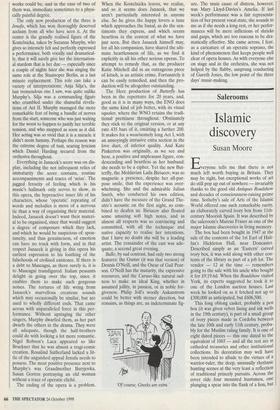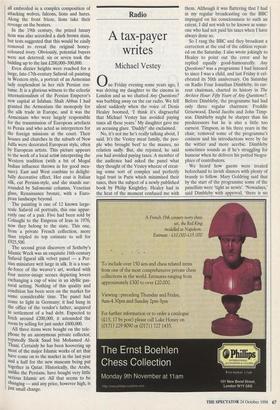Salerooms
Islamic discovery
Susan Moore
Everyone tells me that there is not much left worth buying in Britain. They may be right, but exceptional works of art do still pop up out of nowhere — invariably thanks to the good old Antiques Roadshow and decades of consciousness-raising prime time. Sotheby's sale of Arts of the Islamic World offered one such remarkable rarity, an elaborately carved ivory box from 11th- century Moorish Spain. It was described by the saleroom's Marcus Fraser as one of the major Islamic discoveries in living memory.
The box had been bought in 1947 at the sale of the contents of the 1st Earl of Hali- fax's Hickleton Hall, near Doncaster. Described simply as an 'Eastern' carved ivory box, it was sold along with other con- tents of the library as part of a job lot. The vendor — 12 at the time — remembers going to the sale with his uncle who bought it for £9.19.6d. When the Roadshow visited York, its experts suggested he took it to one of the London auction houses. Last week he looked on as it fetched not up to £300,000 as anticipated, but £606,500.
This long oblong casket, probably a pen box (it was given velvet lining and ink wells in the 19th century), is part of a small group of ivory pieces made in Cordoba between the late 10th and early 11th century, proba- bly for the Muslim ruling family. It is one of eight dated pieces — this one dated to the equivalent of 1003 — and all the rest are in cathedral treasuries and other institutional collections. Its decoration may well have been intended to allude to the virtues of a warrior-ruler, the deep, unusually rhythmic hunting scenes at the very least a reflection of traditional princely pursuits. Across the cover ride four mounted huntsmen, one plunging a spear into the flank of a lion, but all embroiled in a complex composition of attacking wolves, falcons, lions and hares. Along the front frieze, lions take their revenge on the beaters.
In the 19th century, the prized luxury item was also accorded a dark brown stain, but tests suggested that this would be easily removed to reveal the original honey- coloured ivory. Obviously, potential buyers were not deterred; six or seven took the bidding up to the last £200,000-300,000.
Even dizzier heights were reached for a large, late-17th-century Safavid oil painting in Western style, a portrait of an Armenian lady resplendent in her rich Persian cos- tume. It is a glorious witness to the eclectic internationalism of the Persian Emperor's new capital at Isfahan. Shah Abbas I had granted the Armenians the monopoly for the silk trade in Europe, and it was the Armenians who were largely responsible for the transmission of European artefacts to Persia and who acted as interpreters for the foreign missions at the court. Their houses and churches in the suburb of New Julfa were decorated European style, often by European artists. This picture appears to the work of a local artist interpreting the Western tradition (with a bit of Mogul Indian influence thrown in for good mea- sure). East and West combine to delight- fully decorative effect. Her coat is Italian silk, cut Persian-style, and she stands sur- rounded by Salomonic columns, Venetian glass, Renaissance bronze, with a Euro- pean landscape beyond.
The painting is one of 12 known large- scale Safavid oil portraits, this one appar- ently one of a pair. Five had been sold by Colnaghi to the Empress of Iran in 1976; now they belong to the state. This one, from a private French collection, more than tripled its top estimate to sell for £925,500.
The second great discovery of Sotheby's Islamic Week was an exquisite 16th-century Safavid figural silk velvet panel — a Per- sian miniature writ large in silk. It is a tour- de-force of the weaver's art, worked with four mirror-image scenes depicting lovers exchanging a cup of wine in an idyllic pas- toral setting. Nothing of this quality and condition has been seen on the market for some considerable time. The panel had come to light in Germany; it had hung in the office of the vendor's father, acquired in settlement of a bad debt. Expected to fetch around £200,000, it astounded the room by selling for just under £800,000.
All three items were bought on the tele- phone by an anonymous private collector, reputedly Sheik Saud bin Mohamed Al- 'Mani. Certainly he has been hoovering up most of the major Islamic works of art that have come on to the market in the last year and a half for the new museum being put together in Qatar. Historically, the Arabs, unlike the Persians, have bought very little serious Islamic art. All that seems to be Changing — and any price, however high, is Just small change.



















































































 Previous page
Previous page